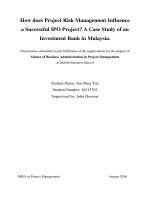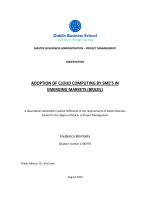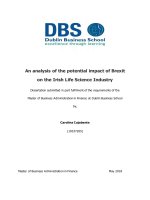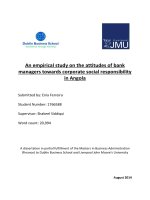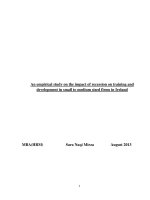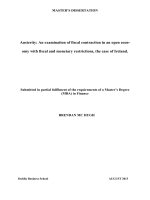Master Thesis in Economics: Customers'' perception of service quality in the commercial banking sector of Nigeria
Bạn đang xem bản rút gọn của tài liệu. Xem và tải ngay bản đầy đủ của tài liệu tại đây (2.32 MB, 120 trang )
Customer’s perception of service quality in the commercial
banking sector of Nigeria:
A case study of Skye Bank PLC. Nigeria
Dissertation submitted in part fulfilment of the requirements for the degree
of Masters in Business Administration (International)
Student Name:
Okoroafor Chukwuemezuo .C.
Student Number: 1212133
Supervisor:
Dr. Catherine Rossiter (PhD).
1
April, 2010
DECLARATION
I declare that all the work in this dissertation is entirely my own unless the words have been
placed in inverted commas (“ „‟) and referenced with the original source. A full reference
section is included with this dissertation.
No part of the work has previously been submitted for assessment, in any form, either at
Dublin Business School or any other Institute.
Signed:……………………………………………
Date:………………….
2
ACKNOWLEDGEMENT
I give thanks to Almighty God, for giving me the strength to carry out this research. I will
like to express my profound gratitude to my supervisor, Dr. Catherine Rossiter (PhD), for her
insightful professional guidance, valuable suggestions, patience, and attention.
My sincere gratitude also goes to my Parents Mr. and Mrs. S.B. Okoroafor, My sisters, in-law
Mr. Ini Ikang for the time and effort he put in for the production of this thesis.
Furthermore, I wish to thank my fiancée Ms. Yoma Akpobome for all her support throughout
my year of study.
3
TABLE OF CONTENTS
Declaration
I
Acknowledgements
III
Table of Contents
IV
Abstract
1
CHAPTER 1: INTRODUCTION
1.1: Background of the Study
3
1.2: The evolution of the Nigerian Banking Industry
3
1.3: Overview of Skye Bank Plc.
4
1.4: Research Objectives
6
1.5: Research Question
6
1.6: Research Hypothesis
7
1.7: Recipient for the Research
7
1.8: Scope and limitations of the Research
7
1.9: Organisation of the Dissertation
8
1.9.1: Chapter 1: Introduction
8
1.9.2: Chapter 2: Literature Review
8
1.9.3: Chapter 3: Research Methodology
8
1.9.4: Chapter 4: Data Analysis and Findings
8
1.9.5: Chapter 5: Conclusion and Recommendation
8
4
1.9.6: Chapter 6: Self Reflection
9
1.10: Major Contribution of the study
9
CHAPTER 2: LITERATURE REVIEW
2.1: Introduction
11
2.2: What are Services?
11
2.3: Service Quality
12
2.3.1: The need for and Impact of Service Quality in Banks
12
2.3.2: Perceived Service Quality in Banks
16
2.4: Customer Perception of Service Quality
17
2.4.1: Factors influencing customer perception of Service Quality
18
2.5: Determinants of Service Quality
19
2.6: SERVQUAL Model
21
2.6.1: Application of the SERVQUAL model in the retail Banking Industry
24
2.8: Customer Satisfaction
25
2.9: Customer Loyalty
27
2.10: Customer Expectation
28
2.11: Conclusion
29
CHAPTER 3: RESEARCH METHODOLOGY AND METHODS
3.1: Introduction
31
3.2: Distinguishing Between Research Method and Methodology
31
3.3: Research Philosophy
32
3.3.1: Positivism
33
5
3.3.2: Realism
34
3.3.3: Interpretivism
34
3.4: Research Approach
35
3.5: Research Choice
36
3.6: Research Strategy
37
3.6.1: Purpose for Survey Strategy
38
3.6.2: Advantages of Survey
38
3.6.3: Disadvantages of Survey
39
3.7: Time Horizon
39
3.8: Research Design
40
3.9: Credibility of the Research Findings
40
3.10: Data Collection
41
3.10.1: Secondary Data Collection
41
3.10.2: Primary Data Collection
42
3.10.3: Questionnaires
42
3.10.4: Production of Internet Questionnaires
42
3.10.5: Rationale for Internet Questionnaires
43
3.10.6: Questionnaire design process
43
3.10.7: Pilot test for the Questionnaire
44
3.11: Population and Sampling
44
3.11.1: Population
44
3.11.2: Research Population defined
44
6
3.11.3: Sampling
45
3.11.4: Sampling Technique
46
3.12: Research Ethics
47
3.13: Conclusion
47
CHAPTER 4: DATA ANALYSIS AND FINDINGS
4.0: Data Analysis and Findings
49
4.1: Quantitative data analysis and finding-Questionnaire
49
4.2: Gender
50
4.3: Age and demographics
50
4.4: Education
51
4.5: Please specify how long you have patronised the bank
53
4.6: Objective 1: To identify the factors influencing customers perception of service in
banks
54
4.7: Objective 2: To evaluate how well the bank satisfies its customers
62
4.8: Objective 3: To access the perception of retail bank customers towards bank service
quality
68
4.9: Hypothesis 1: There is a relationship between service quality and customer
satisfaction in banks
75
4.10: Hypothesis 2: Customer satisfaction has a positive significant impact on customer
loyalty
76
4.11: Conclusion
77
7
CHAPTER 5: CONCLUSIONS AND RECOMMENDATIONS
5.1: Conclusion and Recommendation
79
5.2: Objective 1: To identify the factors influencing customers perception of service in
banks
79
5.3: Objective 2: To evaluate how well the bank satisfies its customers
80
5.4: Objective 3: To access the perception of retail bank customers towards bank service
quality
80
5.5: Hypothesis 1: There is a relationship between service quality and customer
satisfaction in banks
81
5.6: Hypothesis 2: Customer satisfaction has a positive significant impact on customer
loyalty
82
5.7: Recommendation
82
5.8: Main Limitations of the study
84
CHAPTER 6: SELF REFLECTION ON OWN LEARNING AND PERFORMANCE
6.0: Self reflection
86
6.1: Introduction
86
6.2: Learning Style
86
6.2.1: Concrete experience (Kolb)-Activists (Honey and Mumford)
87
6.2.2: Reflective Observation (Kolb)-Reflectors (Honey and Mumford)
87
6.2.3: Abstract (Kolb)-Theorists (Honey and Mumford)
88
6.2.4: Active experimentation (Kolb)-Pragmatics (Honey and Mumford)
88
8
6.3: Masters Experience
88
6.4: Learning Outcomes
89
6.4.1: Research Skills
89
6.4.2: Data Analysis
89
6.4.3: Decision Making Skills
90
6.4.4: Team working Skills
91
6.4.5: Time management Skills
91
6.5: Going Forward
92
BIBLIOGRAPHY
94
APPENDICES
Appendix 1- Questionnaire Request
110
Appendix 2- Customer Perception Questionnaire
111
LIST OF TABLES AND FIGURES
2.1: Service Quality Gap Model
2.1: The determinants of Service Quality
3.1: The Research Process Onion
3.2: Deductive Process
4.1: Gender
4.2: Age
4.3: Education
4.4: Please specify how long you have patronised the bank?
9
4.5: Do you feel the bank provides accurate records of all transactions that have taken
place?
4.6: Do you feel the bank gives a well written guarantee of transaction that has taken
place?
4.7: In your opinion do you think you were informed by the bank about all the product
and services they have available at the bank at the time of opening the account?
4.8: Do you feel the bank provides secure services, for instance “well lit ATM’s for night
time banking or in a safe environment”?
4.9: Do you feel the bank has convenient hours of operation (24 hours a day, seven days
a week)?
4.10: Are you satisfied with the manner with which the staffs approach prospective
customers?
4.11: Are you satisfied with the way the bank deals with your complaints?
4.12: Do you feel the bank processes your transactions efficiently (so you do not need to
wait for long)?
4.13: Please specify any of the bank service(s) applicable to you.
4.14: On a scale of 1 to 5, where 1 stands for very poor and 5 for excellent, what is the
level of your satisfaction with the chosen service(s)?
4.15: Do you contact the bank on telephone or through the Internet when you have any
queries?
4.16: Do you get connected to the service without a waiting time?
4.17: Do you think the bank provides additional options for some customers (customers
with non-English speaking backgrounds/for sight or hearing impaired/elderly?
4.18: Has the bank ever contacted you about your needs or expectations?
4.19: Have you ever stopped using the bank because of poor service?
6.1: Kolb’s Learning Style
10
ABSTRACT
The research study is an investigation into customer perceptions of service quality in the
commercial banking sector of Nigeria: A case study of Skye Bank Plc. The overall goal of
the study is to identify the level to which customers perceive service quality currently
practised in Nigerian banking industry.
Both secondary and primary research methods were employed. About 120 Questionnaires
were administered to customers of Skye Bank Plc. Nigeria. About 101 respondents mainly
customers cooperated for this study. Analyses are presented in charts using Survey Monkey
software.
The data collected through the questionnaire showed that the majority of the customers have
positive perception towards bank services and are immensely satisfied with the quality of
service except that the bank does not provide special services for the disabled and the elderly.
The sample size was limited to only a state in Nigeria and may not be entirely representative.
The study provides a meaningful insight into the efficacy of customer‟s perception of service
quality in the Nigerian banking industry and a useful platform for future studies of service
quality in financial services industry in developing countries.
11
CHAPTER 1: INTRODUCTION
12
CHAPTER ONE
Introduction
1.1
Background to the study
prior to the adoption of service quality in Nigerian banks, the Nigerian banking sector has
been known to be characterised by many issues that have adversely affected the manner to
which customers perceive service quality. This was due to frequent changes in economic
policies made by the Nigerian government during the mid 1980‟s. A known fact was the
introduction of the structural adjustment programme (SAP) in 1986 which led to a floodgate
of banking licenses within the financial services industry.
Between the period of 1985 and 1993 merchant and commercial (licensed) banks operating in
Nigeria increased from 41 to 120 (Central Bank of Nigeria, 1995). By 2004, there were 89
banks operating in Nigeria with many banks having capital base of less than US$ 10 million,
and about 3300 branches compared to 8 banks in South Korea with 4500 branches or one
bank in South Africa with larger assets than all the 89 banks in Nigeria (Soludo .C., Central
Bank of Nigeria 2004).
In order to revive the Nigerian banking industry, the Central Bank of Nigeria (CBN) on July
6th 2004 enacted a decree for banks in Nigeria to increase their share holder capital from the
initial N2 billion to N25 billion with a deadline of December 31,2005. By the end of
December 2005, 25 banks emerged from the 89 banks either through mergers and
acquisitions or by means of organic growth.
Nevertheless, the study seeks to determine customer perception of service quality in the retail
banking sector of Nigeria. To achieve the purpose of this study, one bank: Skye Bank Plc.
that was involved in a merger during the bank consolidation of 2004 and 2005; will be used
as a case study.
1.2
THE EVOLUTION OF THE NIGERIAN BANKING INDUSTRY
13
The first bank in Nigeria was established in 1892, the bank was known as the African
Banking Corporation. The bank was under the control of the British Colonial masters and by
the 1930s, several wholly or partially home-grown banks were established, but the majority
of these banks collapsed subsequently. Banking legislations were nonexistent until 1952, at
which point Nigeria had three foreign banks (the Bank of British West Africa presently
known as First Bank PLC, Barclays Bank now known as Union Bank, and the British and
French Bank presently known as United Bank of Africa) and two indigenous banks (the
African Continental Bank and National Bank of Nigeria). The Central Bank of Nigeria was
established by the CBN act of 1958 and by July 1, 1959 commenced operation and was
authorised to regulate the Nigerian banking industry.
In the 1970s, the Nigerian government initiated direct controls in the banking system, through
the means of ownership, as well as through credit controls and interest rate. As part of an
“indigenisation wave” that had the goal of securing domestic majority ownership of
strategically significant sectors, a number of foreign-owned banks were nationalised, since no
indigenous purchaser could be found (Beck, et al; 2005).
Following the introduction of the Structural Adjustment Programme (SAP) in 1986, the
Nigerian government embarked on a broad programme of financial liberalisation. Interest
rates and entry requirement (in terms of granting bank licenses) were liberalised, and credit
allocation quotas were loosened. The outcome was the dramatic expansion in the amount of
banks operating in Nigeria. However, some of these banks attracted a significant share of
banking industry and have brought benefits for customers in terms of greater contribution and
improved services. Lewis and Stein, (2002) stressed that the number of banks tripled from 40
to nearly 120 in the late 1980s to 90s, employment in the financial services sector doubled
and the contribution of the financial system to GDP almost tripled.
The boom in the financial services sector was accompanied by financial disintermediation.
Deposits in financial institutions and credit to the private sectors, both relative to GDP,
decreased over the period 1986 to 1992. The increasing number of banks and human capital
in the financial industry was thus channelled into arbitrage and rent-seeking activity rather
than financial intermediation (Beck, et al; 2005).
By the 90s, the Nigerian banking industry went from boom to burst; this was as a result of the
increase in non-performing loans (NPL) and insider lending. Especially the merchant banking
14
sector where most of the foreign exchange speculators were concentrated- and the
government owned banks showed increasing signs of distress. The central bank in 1991
introduced new prudential guidelines and also imposed a suspension on new licenses.
Towards the end of the 90s, a number of the banks were liquidated either voluntarily or as
result of actions of failed bank tribunal established in 1994 by the military government to
prosecute cases of misconduct and fraud in the banking industry (Beck, et al; 2005).
However, the Nigerian banking industry has been transformed by the Central Bank of
Nigeria‟s (CBN) July 16th 2004 introduction of the recapitalisation program. Through this
process the numbers of banks were reduced from 89 to 25 by 2005 ending. Presently, the
number of banks has now reduced to 24 following Standard Bank‟s takeover of IBTC. The
banking licenses of 14 banks were revoked. Nevertheless, the objective of the policy thrust
was to build and foster a competitive and healthy financial system to support development
and to avoid systematic distress in the Nigerian banking sector (NPC, 2004; Soludo, 2006).
The reform was to address: shallow dept of the Nigerian capital market, over-dependence of
banking institutions on public sector and foreign exchange trading as sources of funding;
somewhat erroneous returns made by banks to the monetary authorities, and noticeable lack
of harmony between fiscal and monetary policies (NPC, 2004).
1.3
OVERVIEW OF SKYE BANK PLC
Skye Bank PLC has evolved into one of the top financial institutions in Nigeria, after its very
seamless consolidation exercise in January 2006. It is a medium size bank comprising the
merged Prudent Bank, EIB International Bank, Reliance Bank, Cooperative Bank and Bond
Bank. Building on the legacy of two of its largest constituent banks, Skye Bank has become
an active mid-sized operator, with full service operations (Afrinvest, 2009).
The bank operates as a group that provides facets of financial products and services powered
by a purpose built technological framework that supports the service delivery process to
customers.
With a historical ownership and business relationship with the Lagos State Government, the
bank remains an active player in the sub-national public sector space, particularly regarding
revenue collection and public sector financing business (Afrinvest, 2009).
15
The bank is publicly quoted with over 300,000 shareholders that have shareholding structure
that puts no more than 5% in the control of any one individual or company. To date the group
operates out of over 250 branches and transaction centres across Nigeria serviced by over
6000 professional bankers and business experts within N1 Trillion ($7 Billion) balance sheet
size (www.skyebankng.com). In addition, Skye Bank also operates in the traditional
corporate and commercial banking space including exposure to telecommunications, oil and
gas, power, manufacturing, transportation and infrastructure financing business. As part of its
full-service ambitions, the group operates mid-sized subsidiary companies focused on
insurance, capital markets, mortgage origination and trustees/asset management.
In respect of the groups‟ growth and expansion strategy, Skye bank began the process of
exploring commercial and business opportunities in other African countries. The group
concentrated mainly on West African countries. The following are the countries currently
covered under the expansion project Sierra Leone, The Gambia, Liberia, Sao Tome and
Principe, Angola, Congo (DRC), Guinea and Equatorial Guinea. The primary focus is to
develop competencies in countries with similar business culture as Nigeria.
1.4
RESEARCH OBJECTIVE
Saunders, et al., (2007) emphasised that a research may begin with a general focus research
question that generates more detailed research questions, or the general focus research
question as a base from which research objectives could be written. The research objectives
of this study are:
To identify the factors influencing customer perception of service quality in the
Nigerian retail Banks.
To evaluate how well the bank satisfies its customers
To assess the perception of the retail bank customers towards bank service quality.
1.5
RESEARCH QUESTION:
It is of great importance of defining clear research questions at the beginning of the research
process. The importance of this cannot be overemphasised. The key criteria of successful
research will be whether you have a set of clear conclusions drawn from the data collected
(Saunders et al., 2007). However the research question of this study is:
16
How do retail bank customers perceive service quality in Skye Bank PLC.?
1.6
RESEARCH HYPOTHESES:
A hypothesis can be defined as the testable proposition about the relationship between two or
more events or concepts Saunders et al; (2007). Therefore the research hypotheses for this
research are:
There is a relationship between service quality to customer satisfaction
customer satisfaction has a positive significant impact on customer loyalty
1.7
RECIPIENT FOR THE RESEARCH
The principal recipient of this dissertation entitled: “Customer Perception of Service Quality
in the Commercial Banking Sector of Nigeria”: A case study of Skye Bank Plc.
Dublin Business School.
Business Research Methods Module Tutor.
The Liverpool John Moore University.
Skye Bank Plc Nigeria.
However, the research would be of immense importance to all stakeholders in the retail
banking sector.
1.8
SCOPE AND LIMITATIONS OF THE RESEARCH
The research project aims to study customer‟s perception of service quality in the Nigerian
retail banking sector: Skye Bank Plc was adopted as a case study. The scope is to determine
whether customers are satisfied with the level of service quality that is been provided by the
bank.
The research would involve surveying customers of Skye
Bank
PLC.
Furthermore,
an
analysis of existing literature and data available on the topic of service quality will be
undertaken. This would involve Journals, books, and internet articles that relate to this topic.
17
Limitations
There are few limitations in relation to the study. These limitations are outlined belowFirstly, is that the research was focused only on Skye Bank PLC Nigeria as a
representative of the banking industry.
The study was delayed as approval had to be acquired from the management, which
led to cutting of the planned sample size as a result of time constraint.
1.9
ORGANISATION OF THE DISSERTATION
The dissertation is divided into six chapters and they are listed below.
1.9.1 Chapter 1: Introduction
This chapter presents a brief background of the intended research topic, and it also defines the
research objective and question. In this chapter, the hypotheses are highlighted, as well as the
research scope and limitations, and contribution of the research.
1.9.2 Chapter 2: Literature Review
This chapter starts with an introduction on the general research and further discussions on
the topics that relate to the topic of the research. It also outlines the views of key theorists in
services marketing and it will also discuss the limitations related to their works.
1.9.3 Chapter 3: Research Methodology
This chapter outlines the details and explanation of the term research methodology, critical
review of the methodology and the underlying principle for selecting it will be outlined in
this chapter. The research philosophy for the dissertation would be discussed in this chapter,
as well as the population selection and sampling process for the primary research.
1.9.4 Chapter 4: Data analysis and finding
This chapter presents the data analysis and the findings from the primary research conducted
during the study.
1.9.5 Chapter 5: Conclusion and Recommendation
18
The chapter highlights and gives a summary of the main findings in relation to the original
aim of the study, and also gives the appropriate recommendations based on the results
obtained.
1.9.6 Chapter 6: Self Reflections
This chapter gives an analysis of self reflection on learning. This section would also present
an evaluation of the researcher‟s skills and development throughout the researcher masters
degree programme.
1.10
Major contribution of the study
Relevant contributions are made in the different sections of the research work. The literature
review emphasises on the factors influencing customer perception of service quality in the
banking industry irrespective of the geographical location. Also, the research, establishes the
relationship between service quality, customer satisfaction and customer expectation as well
as providing tools for the Nigerian banking industry to improve on service quality.
19
CHAPTER 2: LITERATURE REVIEW
20
CHAPTER 2
LITERATURE REVIEW
2.1
Introduction
In this chapter, revision of the relevant literature is undertaken to provide an overview of the
secondary data referred for the development of this research project. The chapter is divided
into various sections. The first section starts on with the outlook pertaining to the meaning of
services, service quality as well as the need for and impact of service quality in banks and the
determinants of service quality and conceptual models in relation to the term service quality.
The next presents the literature in reference to customer satisfaction, customer loyalty and
customer expectations.
2.2
What are Services?
Concepts of service are of great importance, in developed countries as well as in the
developing countries, this is because of the impact it has in businesses across the world.
Kotler, et al., (2006) defined services as a form of product that consists of activities, benefits,
or satisfactions offered for sale that are essentially intangible and do not result in the
ownership of anything. Examples are banking, hotel, airline, retail, tax preparation, and home
repair services. Gronroos, (1990) was of the opinion that service is a process consisting of
series of more or less intangible activities that normally, but not necessarily, take place in
interactions between the customer and service employees and or physical resources or goods
or systems of the service provider which are provided as solutions to customer problems.
Zeithaml, et al., (1985), summarised the distinct characteristics between goods and services
in that services are heterogeneous, intangible, inseparable, and perishable which cannot be
stored. This results in heterogeneity and high variability in supply and performance of
services. Service delivery also depends on the producer (bank), who is not always able to
guarantee homogeneity in service delivery, so that services performed may not be those
promoted to consumers (Langeard, et al., 1981).
21
Service has three basic attributes. The first are processes consisting of activities, second
being the extent produced and consumed concurrently and thirdly the customer participation
in the production process to an extent. The differences between goods and pure services are
intangibility, simultaneous production, consumption and heterogeneity. At the designing
stage, a proper service system keeps in view the organisations service specifications and
competitors service specifications.
Service organisations aim to keep their customers
satisfied by delivering service according to the standards and functions on quality parameters.
Increase in the service industry across the world has made organisations realise the need to
differentiate from the competitors in some form or the other by providing better service to its
customers and at the same time focus on service quality to attain financial gain. Service
quality has become a critical factor in enabling firms to achieve a differential advantage over
their competitors, and it thus makes a significant contribution to profitability and
productivity.
2.3
Service Quality
Nejati, et al. (2009) emphasised that service quality as a concept, has received much attention
in service marketing literature because of its sustainability as a source of competitive
advantage. The concept of service quality developed from the marketing discipline due to the
difficulty in applying product quality definitions to services (Gronroos, 1982; Lehtinen and
Lehtinen, 1982). Numerous researchers have given different definitions for service quality.
Kasper, et al., (1999) as cited by Nejati, et al., (2009) defined service quality as “the extent to
which the service, the service process and the service organisation can satisfy the
expectations of the user”.
Parasuraman, et al., (1988) defined service quality as “a function of the difference between
service expected and customers‟ perceptions of the actual service delivered”. Gronroos,
(1978) suggests that service quality is built of two components-technical quality and
functional quality. Technical quality refers to what the service provider delivers during the
service provision while functional quality is how the service employee provides the service.
Parasuraman, et al., (1985); Dawkins and Reichheld, (1990); Reichheld and Sasser, (1990)
and Zeithaml et al., (1990) are of the view that in this “customer age”, delivering quality
22
service is considered an essential strategy for success and survival in today‟s competitive
environment.
Based on this notion, the relevance of service quality can be seen a key driver of growth to
organisations, especially the banking industry.
2.3.1 The need for and Impact of Service Quality in banks
Banks in over the world offer similar kinds of services (Lim & Tang, 2000), quickly
matching their competitors‟ innovations. Banks have understood the importance of
concentrating on service quality as a means to increase customer satisfaction and loyalty, and
to improve their core competence and business performance (Kunst & Lemmink, 2000;
Stafford, 1996). This understanding stems from believing that service quality is difficult for
competitors to copy (Reichheld & Sasser, 1990).
Johnston, (1995) stated that service quality is customers‟ overall impressions of an
organisation‟s services in terms of relative superiority or inferiority. It should not only meet
but also exceed customer expectations and should include a continuous improvement process
(Lloyd-Walker & Cheung, 1998). Customers evaluate banks‟ performance mainly on the
basis of their personal contact and interaction (Grönroos, 1990). Judgments are formed by
comparing service expectations with the service actually received (Bloemer, et al., 1998).
In terms of qualitative benefits, customer satisfaction and loyalty have been perceived as
major concerns; it is widely accepted that a business must concentrate on pursuing service
quality to achieve customer satisfaction because survival of the business greatly depends on
that satisfaction (Naumann, 1995). Service quality determines the rate of customer
satisfaction, customer loyalty and ultimately, the competitive advantage of an organisation.
(Leonard and Sasser 1982; Cronin and Taylor, 1992; Gammie 1992; Hallowell, 1996; Chang
and Chen, 1998; Gummesson, 1998; Lasser et al., 2000; Silvestro and Cross, 2000; Newman,
2001; Sureshchander et al., 2002; Guru, 2003; Seth, et al., 2005) all agreed that “During the
past few decades service quality has become a major area of attention to practitioners,
managers and researchers owing to its strong impact on business performance, lower costs,
customer satisfaction, customer loyalty and profitability”.
Parasuraman, et al., (1985) proposes that service quality is a function of the differences
between expectations and performance along the quality dimensions.
23
In the report by Lewis, (1991), an international comparison of bank customers‟ expectations
and perceptions of service quality were made. It was found that in spite of the existence of
very high expectations of service quality and high perceptions services received, gaps did
exist.
Quality in the financial service industry (banks) entails focus on customer care and customercentric attributes. The success of any business model depends not just on margins but more
on ensuring the delivery of value based services to the customers. Delivery of quality service
depends on identifying the gaps between the perceived service quality the customer receives
and what they expect (Zeithaml, Parasuraman and Berry, 1990). Figure 2.1 shows these gaps.
24
Fig 2.1: Service Quality Gap Model
Source: Fig: 2.1 presents the service quality gap model by (Parasuraman, et al. 1985).
The gap identified in the Figure 1 identifies Gap 1 as the difference between what customers
expect of a service and what management perceives customers to be expecting. Gap 2 shows
the difference between what management perceives customers as expecting and the quality
25
